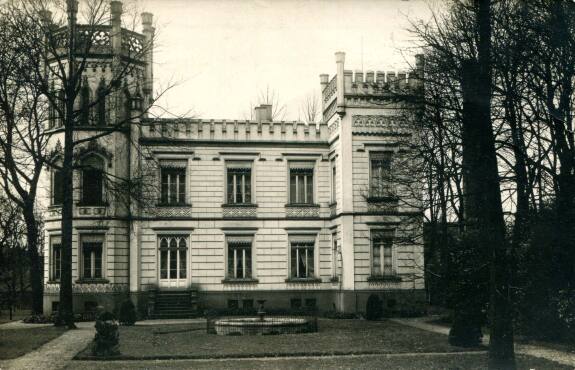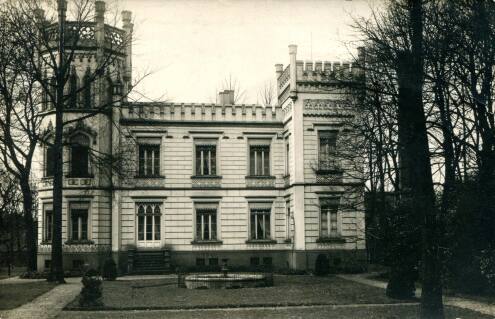Photo of the month - November 2022
The Villa Drießen on Kaiser-Wilhelm-Strasse
Anyone who, on seeing this magnificent building, spontaneously thinks that this is a historical view of the manor house in Märkisch-Wilmersdorf (Brandenburg), part of Kittendorf Castle (Mecklenburg Lake District) or a posh estate in the English provinces is mistaken. Rather, the viewer is presented with a rare view of a classical beauty in the middle of 19th century Bocholt: the image of Villa Drießen on Kaiser-Wilhelm-Strasse.
The merchant Hermann Drießen (1832-1871) built this house in 1863 on the factory site of the former spinning mill Gebrüder Drießen in front of the Neutor south of the Aa. Here you can see the east side of the house, which was built in the English-Gothic style and was taken by a photographer around 1930. The three-part construction of the building immediately catches the eye: the two-storey middle house has an exit with a flight of steps to the garden, and the attic with rectangular battlements at the top almost completely hides the roof. The windows are fitted with shutters with sheet metal panelling. To the left, a three-storey attached corner tower dominates in the form of an octagon with rectangular, twin and pressed lancet windows and a crowned roof structure.
In contrast, the slightly smaller corner tower on the right is square in outline and has a crenellated finial and slender, freestanding corner columns. Neo-Gothic decorative elements with tracery bands in the form of so-called nuns' heads and trefoil and quatrefoil ornaments below the windows are found everywhere on the façade.
The photo may have been taken on a November day. On closer inspection, one discovers on the right behind the tall trees the still existing, around 34-metre-high and listed factory chimney of the former Drießen spinning mill, which is now structurally attached to the shopping centre of the shopping arcades.
Cotton straight from England?
It is said that the factory owner Hermann Drießen once bought the cotton raw materials directly from England. In this respect, it is quite possible that he occasionally stayed there and incorporated his impressions gained from an architectural point of view into the plans for his residential building.
His brother Carl Drießen (1841-1921) inherited the estate, then his son Albert Drießen (1871-1934). During the heavy bombing raid on Bocholt, the Drießen villa was completely destroyed by fire on 22 March 1945. In mid-November 1959, the family's community of heirs applied for the demolition of the ruins on the corner of Hohenzollernstraße, which began immediately. Subsequently, the construction of sales and storage rooms for the installation company "Concordia Elektrizitäts AG" (CEAG) began there. Today, Ludwig-Erhard-Straße stretches along the site.




